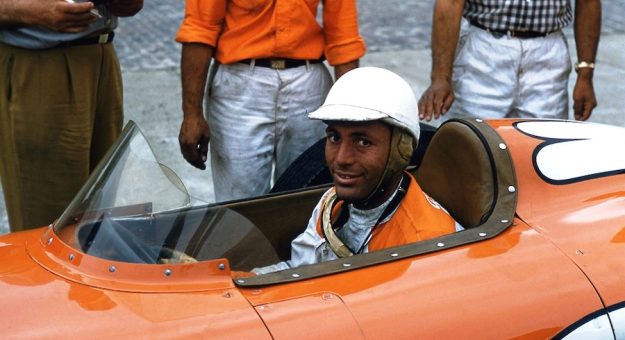In the years following World War II, a host of young drivers from California invaded Indianapolis Motor Speedway.
Their skills honed by year-round racing in the Golden State’s balmy climate, they transformed the face of racing at the old, historic Brickyard. For years, the eventual Indy victor would set a predetermined speed for the race, and determinedly stick to that plan for the 500 miles.
By 1950, however, the California upstarts arrived and treated the race like a midget or roadster feature, with all-out charges to the checkered flag. Talented Bob Scott was among them.
Born in Watsonville, Calif., in 1928, he was a natural athlete, lettering in several sports at Gardena High. Inundated by the quantity of racing in Southern California, he soon turned his athletic attributes to driving race cars. He got his first taste of the sport with the tough, competitive CRA roadsters at nearby Carrell Speedway in 1948.
There he had to deal with the likes of Troy Ruttman, Jack McGrath, Andy Linden and Manny Ayulo. Yet, in only two years, Scott had so favorably demonstrated his ability that he attracted car owners who invited him “back east” to run with the top echelon of the sport — AAA.
He attacked the daunting Midwest high banks — Winchester Speedway, Salem Speedway and Dayton Speedway — with such aplomb that by 1951 the 23-year-old had already made his way to Indianapolis.
In a less-than-competitive car, he missed the show. Then, a disappointing year turned worse when his arms and legs were severely burned in a crash at Toledo (Ohio) Speedway.
Scott returned home and for a time considered giving up racing. But 1950 500 winner Johnnie Parsons took a liking to him and encouraged him to continue racing.
“Scotty” was well-liked by his competitors for his obvious potential, but also for his quiet, modest demeanor. However, some thought he was too reserved. They believed his hesitation to boast cost him the better rides he deserved. Parsons helped him land a ride in Ernie Ruiz’s top-line sprint car.
In the Ruiz car, Scott stood out on the AAA tracks and returned to Indianapolis in 1952. With Parsons’ help he got the seat in Doc Morris’ KK2000/Offy, made the race and ran well before falling out with a broken driveshaft.
He returned to the speedway in 1953 driving the Belond Equa-Flow Exhaust Special but struggled to get it up to speed until three-time 500 winner Mauri Rose sat with him on the pit wall for an intense consultation.
Scott immediately picked up his pace and qualified in the middle of row four. “That guy Rose is terrific,” Scott exclaimed afterward.
Scott’s fine run also proved spirit-lifting for car owner Lou Bromme. He was gravely ill at the time and Scott’s performance lifted his spirits in the last days of his life. Bromme died shortly after the race.
For Indianapolis in 1954, Scott signed to drive the Ernie Ruiz, Travelon Trailer Kurtis 500B roadster, perhaps his best ride at the speedway. He qualified early and fast.
However, 1954 was a year when the qualifying speeds jumped unexpectedly as the month wore on. What initially had seemed a safe speed was not. Scott was bumped.
Desperate, he pursued a ride in another car. With only 20 minutes of qualifying time remaining on the last day, he took to the track in the lightly regarded Ray Bradley Special. He had no practice but was quick. Very quick. His first lap was over 138 mph. His next topped 139. He appeared to easily be on his way to bumping into the field.
But on his final lap, he slowed. His run ruined. In the stress and chaos of those last, tumultuous moments of Bump Day, Scott had mistaken the white flag for the checkered. Disconsolate, he sobbed in the garage afterward.
His attempt, although unsuccessful, opened the eyes of many to his talent. His future seemed limitless. He could very well, observers insisted, be one of racing’s best. But it was not to be.
Within weeks Bob Scott was dead. He died from injuries suffered in a crash at Darlington (S.C.) Raceway on July 5, 1954.
Only 25, his accomplishments during his brief stint at the top of the sport are but a blip on the radar screen. Lasting fame wasn’t his contribution to the rich history of auto racing. What was is the manner in which he pursued the sport he loved — with enthusiasm, zest and hope.
